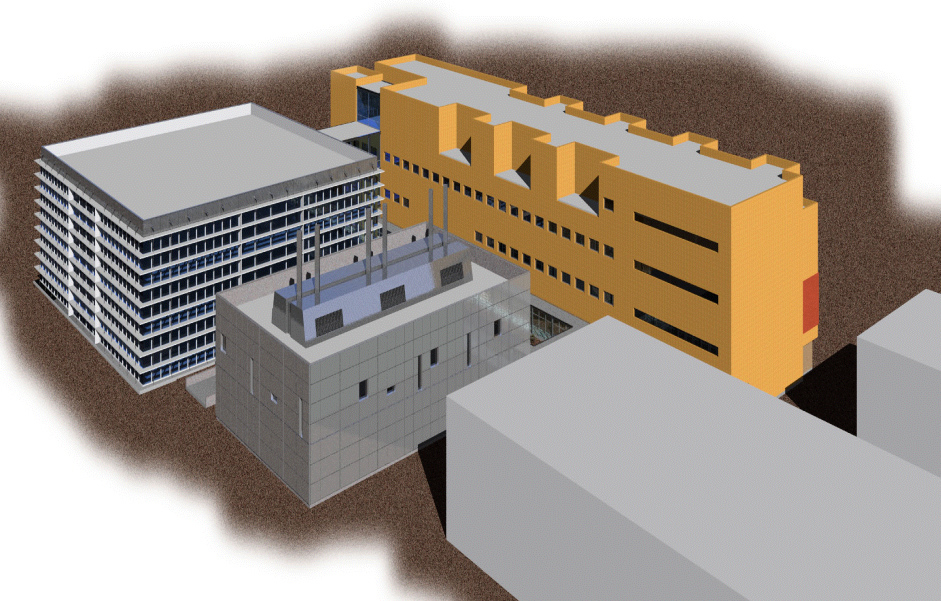
Download 300dpi JPEG image, ‘MESA.jpg’, 476K (Media are welcome to download/publish this image with related news stories.)
Albuquerque, N.M. — The largest construction project ever proposed by the Department of Energy’s Sandia National Laboratories — the $300 million Microsystems and Engineering Sciences Application (MESA) facility — has received DOE approval for the Laboratories to proceed with a conceptual design.
The purpose of the project is to join Sandia’s expertise in weapon design, very fast computing, and microsystems into an immersive environment in which scientists can imagine, design and create the 21st century’s best non-nuclear components of nuclear weapons.
Other benefits include offering American businesses and universities new opportunities to advance through use of the cutting-edge science that the facility and its programs will provide in microsystems and computer-aided design and simulations.
One advantage of the new microsystems militarily will be that they are expected to reduce the likelihood of malfunction in the event of an unexpected event, like a crash involving nuclear weapons.
“A big arming or safety device involved in an accident severe enough to destroy or fire off a missile would most likely be damaged as much as the explosive device,” says David Plummer, nuclear weapon representative for MESA.
Microsystems designed by high-speed computers are smaller than postage stamps. Their components have little mass, so they have little inertia — the force that keeps an object in motion once it is put in motion. Inertia throws passengers forward, for example, when a car comes to a sudden stop. The amount of inertia an object possesses is a key factor in how much damage it may suffer. Devices of extremely low mass, having almost no inertia, have no problem stopping very suddenly and thus are difficult to destroy on impact.
“As the magnitudes of potential accidents increase — as jet fuel gets hotter, as air speeds get faster — so do the possibilities of accidents exceeding our current controls. We need more rugged safety devices,” says Plummer. “MESA will produce them.”
The primary function of the facility will be the defense of the United States, says Tom Hunter, senior vice-president of nuclear weapons, and will include weapon component modeling and simulation, weapon certification, and embedded microsystems.
However, MESA also represents the leading edge of industry’s interest in intelligent microsystems, says Dan Hartley, vice-president for laboratory development. “The demand for less expensive, more intelligent, smaller systems is ubiquitous in industry, and we believe that what we’re doing here represents the birth of a new field of business endeavor.”
Al Romig, Sandia vice-president for science, technology, and components, says, “This will create a capability to do our business in a new way. It’ll revolutionize the way we’ll refurbish the nuclear stockpile and build new space satellites. It will also be an opportunity to drive the creation of entirely new industries in the United States, using our Science and Technology Park.”
“Conceptually, MESA is a new way of designing intelligent, autonomous, reliable microsystems from the outset and will be the wave of the future for all complex commercial products that will incorporate microsystems, such as cars, planes, and computers,” says David Goldheim, director for Sandia’s corporate business development and partnerships. “At an appropriate time, we plan to ask businesses to become involved in the design of portions of the program. Industry will help design and use parts of the new facility.”
MESA is also of interest to universities, “because in our meetings with deans, microsystems are a high priority with them as well, and they want to have more to do with us because we will be defining the leading edge,” adds Hartley.
Regarding students, says Don Cook, director of the MESA project, “Students in school are being trained in new technologies. We can’t expect to train the brightest graduates on old technology. We want them to advance new technology even further. That’s why we’re a national lab.” Approximately $95 million is slated to be funneled into new equipment for MESA, says Cook.
Says John Stichman, director of weapon systems engineering in New Mexico for Sandia, “As we refurbish weapons, we need to know that those weapons we return to the stockpile meet our safety and capability requirements. These requirements pertain to the next several decades of life these weapons would have in the stockpile. Microsystems hold the promise to provide the most capable implementation of the safety of refurbished weapons. The nuclear weapon systems organization is working closely with the MESA planning staff to assure that MESA is well-aligned with weapons systems design and development.”
The tentative schedule is to begin engineering design in fiscal year 2000 and construction in 2001. The project is scheduled for completion by 2003, and to be fully operational by 2004. MESA eventually will house 600 employees.